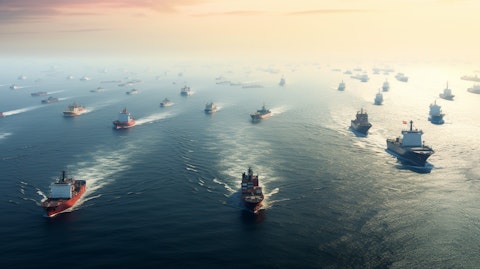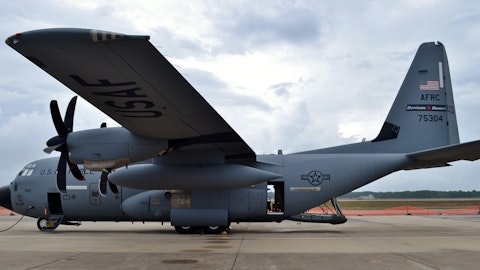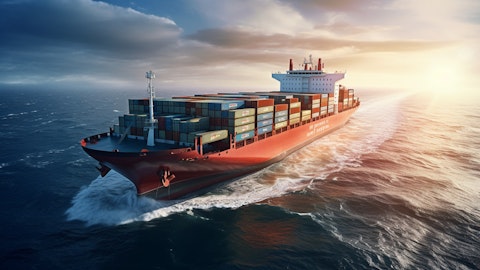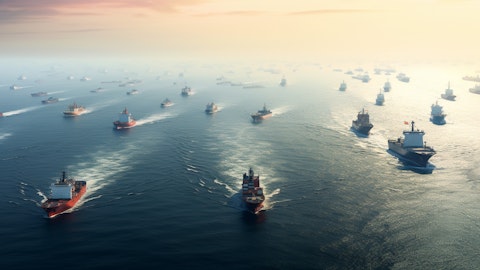Danaos Corporation (NYSE:DAC) Q4 2023 Earnings Call Transcript February 14, 2024
Danaos Corporation isn’t one of the 30 most popular stocks among hedge funds at the end of the third quarter (see the details here).
Operator: Good day, and welcome to the Danaos Corporation conference call to discuss the financial results for the Three Months ended December 31, 2023. As a reminder, today’s call is being recorded. Hosting the call today is Dr. John Coustas, Chief Executive Officer of Danaos Corporation; and Mr. Evangelos Chatzis, Chief Financial Officer of Danaos Corporation. Dr. Coustas and Mr. Chatzis will be making some introductory comments, and then we will open the call to a question-and-answer session. Please go ahead.
Evangelos Chatzis: Thank you, operator. Good morning, everyone and thank you for joining us today. Before we begin, I quickly want to remind everyone that management’s remarks this morning may contain certain forward-looking statements and that actual results could differ materially from those projected today. These forward-looking statements are made as of today, and we undertake no obligation to update them. Factors that might affect future results are discussed in our filings with the SEC, and we encourage you to review these detailed safe harbor and risk factor disclosures. Please also note that where we feel appropriate, we will continue to refer to non-GAAP financial measures such as EBITDA, adjusted EBITDA, adjusted net income, time charter equivalent revenues and time charter equivalent dollar income per day to evaluate our business.
Reconciliations of non-GAAP financial measures to GAAP financial measures are included in our earnings release and accompanying materials. With that, let me now turn the call over to Dr. John Coustas, who will provide the broad overview of the quarter. John?
John Coustas: Thank you, Evangelos. Good morning, and thank you all for joining today’s call to discuss our results for the fourth quarter of 2023. Danaos continues to deliver strong results in the fourth quarter of 2023 as geopolitical events continue to impact global shipping markets. Mostly recently, the conflict in the Middle East expanded to the seas with attacks on vessels in the Red Sea area. These dramatically older trade routes and the performance of liner companies, as most major companies decided to re-route their vessels away from the Suez Canal, sailing longer distances around the Cape of Good Hope to reach Europe. This in turn increased on mild demand leading to capacity shortage, that drove box rates significantly higher up, up to 300%, while it’s expected that box rates will remain elevated as long as the disruption continues.
Against this backdrop, we have some secured additional charters for our vessels at very healthy levels. In the fourth quarter of 2023, Danaos completed delivery of all seven capesize vessels that we had agreed to acquire earlier in 2023. Subsequent to the end of the year, we entered into agreements to acquire two additional capesize vessels as we continued to diversify our revenues and look to capture upside from a healthy dry box market. The market for capesize vessels is shown unusual seasonal strength. As Brazilian iron ore exports increased, coal trade remains elevated. Demand for minor bulk like box size and agricultural commodities is following global recovery. Recent stimulus measures in China aimed at supporting construction, infrastructure projects and consumer demand is expected to keep demand steady as fleet growth begins to slow over the next two years.
We continue to explore interesting opportunities in the dry bulk sector. Danaos has also recently ordered two more 8,150 ATV vessels at Yangtze Yang shipyard and we have now a total of four vessels under construction at that yard with delivery schedule for second half of 2026 and first quarter of 2027. All 12 vessels in our new building program are methanol ready and are designed with the latest eco characteristics. Demand for shipyard delivery slots is very high as the industry is quickly moving to reduce carbon emissions by operating green vessels. As we continue to execute our strategy, we remain focused on taking actions that will ultimately benefit our shareholders. The analysis well positioned with a very strong balance sheet and significant revenue visibility into 2025.

This provides us with the flexibility to return value to our shareholders through dividends and share repurchases and also pursue opportunities to ensure the long-term resilience of the company. With that, I’ll handover of the call back to Evangelos, who will take you through the finances for the quarter. Evangelos?
Evangelos Chatzis: Thank you and good morning again to everyone. I will briefly review the results for the quarter and then we will open up the call to Q&A. We are reporting adjusted EPS for the current quarter of $6.99 per share or $136 million compared to $6.99 per share of EPS for the fourth quarter of 2022 or $141.7 million. This decrease of $5.7 million in adjusted net income between the two quarters is primarily the result of a $9.6 million increase in total operating costs, mainly due to the recognition during the current quarter of previous costs related to voyeur [ph] starters of our dry bulk capesize fleet and a $3.2 million reduction in operating revenues, mainly due to vessel disposals and non-cash revenue recognition accounting, all that being partially offset by a $6.9 million improvement in net finance costs, driven by the significant deleveraging of our balance sheet.
Vessel operating expenses remained almost the same to $40.1 million in the current quarter, compared to $40 million in the fourth quarter of 2022 and while our daily operating cost decreased to $6,188 per day compared to $6,417 per day for the fourth quarter of 2022, OpEx increased due to the increase in the average number of vessels in our fleet. Our operating costs continue to remain among the most competitive in the industry. G&A expenses increased in Q4 by $7.5 million, mainly due to increase in stock-based non-cash costs, and they came in at $22.4 million in the current quarter, compared to $14.9 million in the fourth quarter of 2022. Interest expense, excluding amortization of finance costs, decreased by $7.8 million to $3.1 million in the current quarter, compared to $10.9 million in the fourth quarter of 2022.
The decrease in interest expense is a combined result of a $5.4 million decrease in interest costs because of deleveraging. Our average indebtedness review was lower by almost $400 million between the two periods and all that was partially offset by an increase in the cost of debt service by approximately 130 basis points as a result of rising interest rates and we also had a $2.4 million decrease in interest expense due to capitalization of interest on our vessels under construction. At the same time, interest income came in at $2.7 million, effectively covering almost 90% of our interest expense for the current quarter. And this effectively reflects the almost net debt zero position that we have today. Adjusted EBITDA decreased by 2.2% or $3.8 million, to $172.6 million in the current quarter, from $176.4 million in the fourth quarter of 2022, for reasons that have been already outlined earlier on this call.
We also encourage you to review our updated Investor Presentation that is posted on our website, as well as subsequent events’ disclosures. I will mention a few of the highlights. Our contracted cash revenue backlog remains strong at $2.3 billion with a three-year average charter duration, while contract coverage is at 95.8% for 2024 and 62% for 2025 in terms of operating-based coverage. Our Investor Presentation has an analytical disclosure on our contracted charter book that you can refer to. As of December 31, 2023, our net debt is down to $138.7 million, and in the current interest rate environment, this low net debt position shields us from high interest costs. Additionally, the company’s net debt to adjusted EBITDA ratios to that 0.2 times, while 51 vessels out of our 75 vessels are currently unencumbered and debt-free.
Finally, as of the end of the fourth quarter, cash was at $272 million, while total liquidity, including availability under our revolving credit facility, stood at $609 million, giving us ample flexibility to pursue accretive capital deployment opportunities. With that, I would like to thank you for listening to this first part of our call. Operator, we are now ready to open the call to Q&A.
See also 12 Younger Woman Older Man Dating Sites in the US and Top 20 Biggest Mortgage Companies in the US.
Q&A Session
Follow Danaos Corp (NYSE:DAC)
Follow Danaos Corp (NYSE:DAC)
Operator: [Operator instructions] The first question today comes from Omar Nokta with Jefferies. Please go ahead.
Omar Nokta: Thank you. Hi, John and Evangelos. Good afternoon. Just have a couple of questions for you. You’ve obviously added the five charters on those 5,000 to 6,000 TEU ships at better rates in terms and I think a lot of us expected coming into the year, especially given where the market was at the end of ’23. It looks like each of those has gotten about a year or so of duration. I wanted to ask, what’s the liner appetite looking like right now? You mentioned freight rates being elevated and they’ll continue to be so as long as the Red Sea diversions are in place. How is the appetite now for further chartering? Is there a specific vessel class that you see liners targeting at this point?
John Coustas: Well, Omar, we do not really, of course, due to the shortage at present, everybody is interested in prompt vessels and we have practically nothing until yearend, maybe one or two ships in the second half. So really, I cannot really tell you. What is definite is that there is significant demand from all line of companies for modern vessels for even for future 25 deliveries or 26 deliveries, but that’s for the very modern vessels and there is significant demand for let’s say, the other six new buildings that we do not have, let’s say, presently committed and we are in negotiations for all of them.
Omar Nokta: And then maybe just a follow up, obviously, you’ve been expanding kind of opportunistically within the dry bulk segment. You’ve got the nine capes now. Looks like containers are still the core business. You do have plenty of liquidity and flexibility. Just wanted to get a sense of any thoughts on where you see the Cape fleet going from here in terms of size. Is there a certain critical mass you’re trying to get that segment up to?
Evangelos Chatzis: As we said, we are going into this segment in order to, let’s say, to build it up. Of course, as I’ve already said a number of times, the dry bulk market is quite cost sensitive and we’re not going to chase the market up. Already, the prices in the market, at least for the first, let’s say, seven ships that we got is at least, let’s say, 15%, maybe 20% up in some instances. So, we are pretty careful. Of course, it’s a segment that we want to grow, but we will do it in a kind of a measured way. There is no hurry for that. Our main business will continue to be, let’s say, the container segment where we have our competitive edge and we will move cautiously as we have always done.
John Coustas: Makes sense. Thank you. One final one and I know it’s a bit sensitive, but just wanted to ask in terms of the Eagle Bulk Holding you have, it’s gone up nicely in value since you took the stake. Anything you’re willing to say about the plan merger with Star Bulk and do you see this holding as sort of a core long-term investment or is this more of an opportunistic trade? We have not really decided really how we’re going to handle that. For the time being, we do not have any, let’s say, any reason to get out of this investment and we will see how it develops.
Omar Nokta: Okay, thank you. That’s clear enough. All right, thank you, John. I’ll turn it over.
Operator: Thank you. The next question is from Clement Mullins with Value Investors. Please go ahead.
Clement Mullins: I wanted to start by asking about the cape sizes you have added over the past few months. Utilization during the quarter was at that lower than expected. Could you provide some commentary on the drivers behind that? Was it due to the delivery of the vessels? And secondly, could you give us some insight on the utilization you expect to realize in the first quarter?
John Coustas: Yes, let me take that. First of all, we took delivery of the vessels during Q4, right? And upon taking delivery, we performed certain repairs on the vessels to bring them up to our standards. So there were certain scheduled days that the vessels were off higher. Hence, the 82% almost utilization that you see now is not indicative of how the vessels will be utilized. There are — the vessels are scheduled to — some of them, to go to dry dock in Q1 and Q2 and Q3 of this year. So there we may — you may expect to have two or three weeks of downtime, but other than that, we expect them to be fully utilized.
Clement Mullins: Thanks for the color. I also wanted to ask about the new bills, I would, two you have added recently and the ones that remain unfixed. Should we expect a charter announcement in the foreseeable future or do you plan on waiting until closer to delivery before securing a charter?
John Coustas: We are already in discussions. So, yeah, we may very well announce something, but, we don’t have, for us, most companies in order to contract the vessels, wanted to have a charter beforehand. For us and with the strength of our balance sheet that practically we can practically buy the vessels with existing liquidity and we don’t need financing. We can wait as long as we want if we do not find the rates that make sense to us. So, we can always wait. Modern vessels are definitely scarce and we believe that our strategy is going to make much more sense rather than ordering on the back of a long-term charter where your return rates are pretty squeezed.
Clement Mullins: Makes sense. That’s all for me. I’ll pass it over. Thank you for taking my questions.
Operator: Thank you. It appears we have no further questions at this time. I would like to turn the call back over to Dr. Coustas for any closing remarks.
John Coustas: Yes, thank you all for joining us to this conference call and your continued interest in our story. Look forward to hosting you on our next earnings call. Have a nice day.
Operator: Thank you. This concludes today’s teleconference. We would like to thank everyone for their participation. Have a wonderful afternoon.





